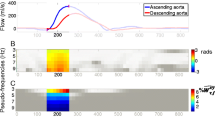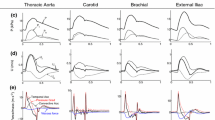Summary
The timing and amplitude of reflected arterial waves in the ascending aorta were studied by analysis of the aortic pressure waveform and were compared with those derived using wave intensity analysis. Wave intensity analysis considers aortic pressure changes to be the result of forward and backward wavelets carrying energy. Wave intensity (dI = dPdU) is calculated from changes in pressure (dP) and flow velocity (dU), and its sign indicates the direction of travel of propagating wavelets (positive for forward-traveling waves and vice versa). We measured aortic pressure and flow velocity in 14 patients, mean age 60 ± 9 years, with three-vessel coronary artery disease at the time of surgical revascularization. The travel time of the reflected wave derived from analysis of the aortic pressure wave-form (t p) was measured from the foot of the aortic pressure waveform to the inflection point of the aortic pressure (derived objectively from the zero of second derivative of aortic pressure). From wave intensity analysis, the travel time of the reflected wave was measured to the onset of the wave intensity of the backward-traveling wave dI_ (t i), and to the onset of the separated backward pressure wave (t b). All patients showed an aortic pressure waveform characterized by an inflection point on the rising limb of the aortic pressure, followed by a secondary rise in pressure, representing the return of reflected waves. Wave intensity analysis consistently showed a negative peak in mid systole, the timing of its onset corresponding closely to the inflection point of the aortic pressure. The travel time of the reflected wave derived from the analysis of the aortic pressure waveform (t p) was 121 ± 21ms and showed close agreement witht i (118 ± 28ms) andt b (115 ± 29ms), with mean differences of 4 and 6ms, and 95% confidence intervals of difference (−2 to 7 ms) and (1 to 12ms), respectively. The augmentation index, a measure of the secondary increase in aortic pressure due to reflected waves, was significantly correlated with the magnitude of dI_ (r = 0.63,P < 0.001). Wave intensity is a quantity that indicates the rate of energy flux due to wave travel and since its value is positive for forward-traveling waves and negative for backwardtraveling waves, its calculation allows the timing of reflected waves to be accurately predicted. Furthermore, the magnitude of wave intensity in backward-traveling waves (dI_) is related to the augmentation index and may provide a measure of the amplitude of the reflected wave. This analysis of the arterial system is done in the time domain and therefore can be easily applied to assess temporal changes in arterial characteristics.
Similar content being viewed by others
References
O'Rourke MF (1982) Arterial function in health and disease. Churchill Livingstone, Edinburgh, pp 77–93
Nichols WW, O'Rourke MF (1997) McDonald's blood flow in arteries, 4th edn. Edward Arnold, London, pp 203–220
Latham RD, Westerhof N, Sipkema P, Rubal BJ, Reuderink P, Murgo JP (1985) Regional wave travel and reflections along the human aorta: a study with six simultaneous micromanometric pressures. Circulation 72:1257–1269
Murgo JP, Westerhof N, Giolma JP, Altobelli SA (1980) Aortic input impedance in normal man: relationship to pressure wave forms. Circulation 62:105–116
Avolio A (1992) Ageing and wave reflection. J Hypertens 10:S83-S86
Kelly R, Hayward C, Avolio A, O'Rourke MF (1989) Noninvasive determination of age-related changes in the human arterial pulse. Circulation 80:1652–1659
Nichols WW, O'Rourke MF, Avolio AP, Yaginuma T, Murgo JP, Pepine CJ et al (1985) Effects of age on ventricular-vascular coupling. Am J Cardiol 55:1179–1184
Westerhof N, O'Rourke MF (1995) Haemodynamic basis for the development of left ventricular failure in systolic hypertension and for its logical therapy. J Hypertens 13:943–952
Kirkpatrick RD, Campbell KB, Bell DL, Taheri H (1991) Method for studying arterial wave transmission effects on left ventricular function. Am J Physiol 260:H1003–1012
Yaginuma T, O'Rourke MF (1993) Modification of wave travel and reflection by vasodilator therapy. In: O'Rourke MF, Safar M, Dzau V (eds) Arterial vasodilatation — mechanisms and therapy. Edward Arnold, London, pp 50–60
Westerhof N, Sipkema P, Van den Bos GC, Elzinga G (1972) Forward and backward waves in the arterial system. Cardiovasc Res 6:648–656
Van Den Bos GC, Westerhof N, Elizinga G, Sipkema P (1976) Reflection in the systemic arterial system: effects of aortic and carotid occlusion. Cardiovasc Res 10:565–573
Merillon JP, Lebras Y, Chastre J, Lerallut JF, Motte G, Fontenier G et al (1983) Forward and backward waves in the arterial system, their relationship to pressure waves form. Eur Heart J 4:13–20
Parker KH, Jones CJ (1990) Forward and backward running waves in the arteries: analysis using the method of characteristics. ASME J Biomech Eng 112:322–326
Jones CJ, Sugawara M (1993) “Wavefronts” in the aorta — implications for the mechanisms of left ventricular ejection and aortic valve closure. Cardiovasc Res 27:1902–1905
Press WH, Flannery BP, Teukolsky PA, Vetterling WT (1995) Numerical recipes in C. Cambridge University Press, Cambridge, pp 650–655
Bland JM, Altman DG (1986) Statistical methods for assessing agreement between two methods of clinical measurement. Lancet 1:307–310
Ramsey MW, Sugawara M (1997) Arterial wave intensity and ventriculoarterial interaction. Heart Vessels Suppl 12:128–134
Laskey WK, Kussmaul WG (1987) Arterial wave reflection in heart failure. Circulation 75:711–722
Stefanadis C, Wooley CF, Bush CA, Kolibash AJ, Boudoulas H (1987) Aortic distensibility abnormalities in coronary artery disease. Am J Cardiol 59:1300–1304
Dart AM, Lacombe F, Yeoh JK, Cameron JD, Jennings GL, Laufer E et al (1991) Aortic distensibility in patients with isolated hypercholesterolaemia, coronary artery disease, or cardiac transplant. Lancet 338:270–273
Parker KH, Jones CJ, Dawson JR, Gibson DG (1988) What stops the flow of blood from the heart? Heart Vessels 4:241–245
Jones CJH, Parker KH, Sugawara M (1991) Energy wave generation by the left ventricle — influence of contractility and vasomotor tone (abstract). Br Heart J 66:78
Milnor WR (1989) Wave reflection. In: Milnor WR. Hemodynamics. Williams and Wilkins, Baltimore, pp 204–224
Author information
Authors and Affiliations
Additional information
T.W.K. is supported by the British Heart Foundation
Rights and permissions
About this article
Cite this article
Koh, T.W., Pepper, J.R., DeSouza, A.C. et al. Analysis of wave reflections in the arterial system using wave intensity: A novel method for predicting the timing and amplitude of reflected waves. Heart Vessels 13, 103–113 (1998). https://doi.org/10.1007/BF01747827
Received:
Accepted:
Issue Date:
DOI: https://doi.org/10.1007/BF01747827




